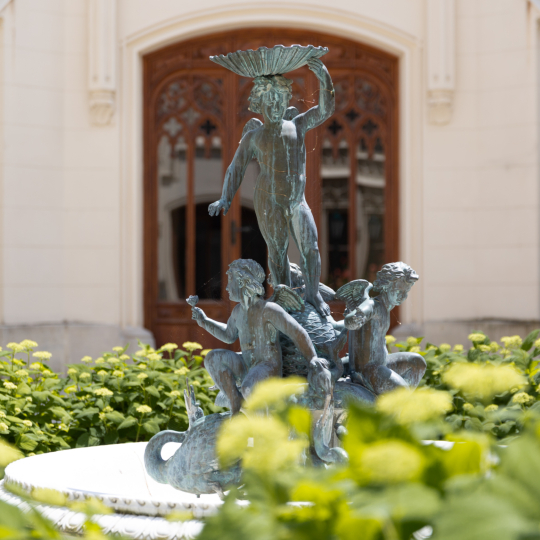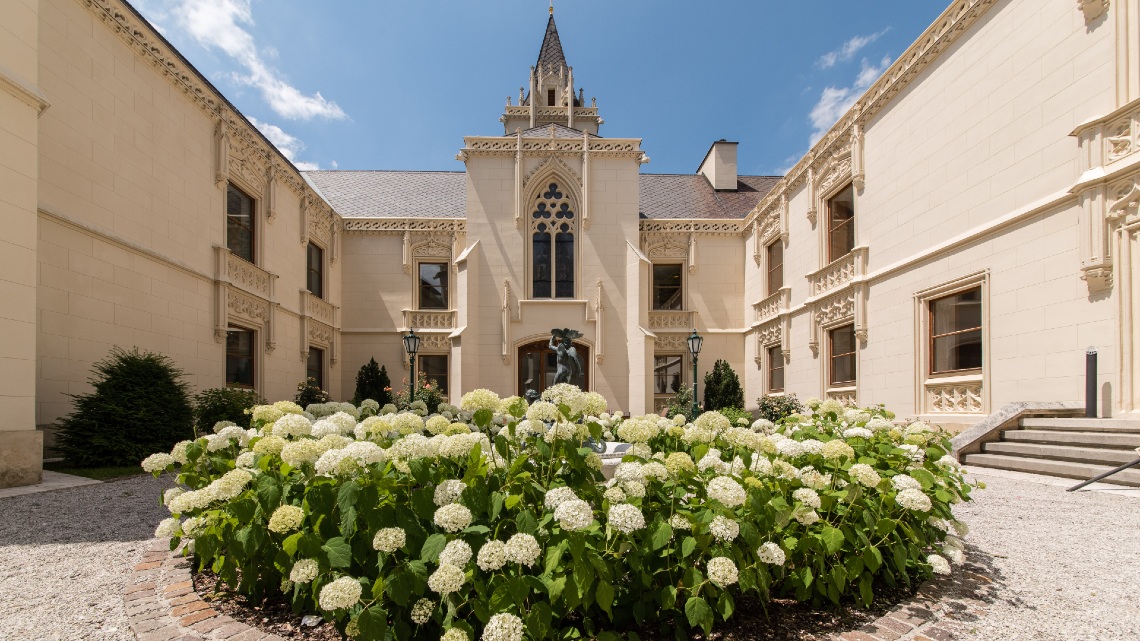The Architecture
The Victorian estate, embedded in a 6-hectare English park, is reminiscent of a campus of a traditional English elite university, such as Eton or Oxford.
Our focus when it came to considering the redesign of the guest area was what makes your stay a very special experience that you will remember with fondness. Preserving the history of the castle and establishing the connection to the present day was a special challenge during the architectural redesign, which we addressed with passion and attentiveness.
The historic rooms
Carl Rahl created the eight fresco paintings on the chapel’s ceiling, which depict some patrons of the house of Habsburg. The Carrara marble Pieta by Pompeo Marchesi and the glass painting by Carl Geyerling are of great value.
The former bedroom of Leopold Ludwig was housed in the Carl von Rahl Room. The ceiling painting by Christian Griepenkerl with its themes of Morning, Night, Sleep and Dream, successfully link to the room’s purpose.
The ancestral line in the wood-panelled Habsburgersaal (Habsburg Room) is by August Eisenmenger; the ceiling painting by Eduard Bitterlich is an allegorical depiction of the virtues of a true Austrian: blood in the fire = love of the fatherland, snake = durability, lion = courage, scales = justice, sadness, magnanimity and wisdom. The Ahnensaal (Room of Ancestors) – as it was called at the time – was the largest apartment on the first floor. This room is directly connected to the reception hall, the Musikverein, through wide sliding doors.
This room is reminiscent of the large Musikverein hall in Vienna, the ceiling painting is by Christian Griepenkerl and reflects the Habsburgs’ great passion for hunting. Diana, goddess of the hunt, is in the middle (original condition): ibex = strength; lion = courage; fox = cunning; eagle = keen vision.
The only wood-carved ceiling in the castle is found in the Wappensaal (Armorial Hall). At the time it was created, the ceiling cost the equivalent of 30 farms.
The historic floor is made of oak parquet with rosewood inlays. This room was the former dining room of Leopold Ludwig.
The Teichblick (Pond View) room – the former smoking salon – with its view of the pond is behind the Wappensaal.
The self-supporting grand staircase is made of Untersberg marble. The walls panels are marble mixed with plaster dust, applied with stencils and polished with stone oil. The ceiling have stucco work.
In the Pferdezimmer (Horse Room), pictures by Stotz and Klein, the best-known horse painters of the period, show the horse-breeding activities of the Habsburgs. This room was originally a library.
Alongside the study and the library, the garden salon was the architectural and social centre on the ground floor. It appears that delicate bronze pillars carried the ceiling, which was made of a Persian silk shawl that Napoleon once received as a gift from a Bedouin sheikh.
 Schloss Hernstein
Schloss Hernstein
 Peter Hruska
Peter Hruska
Story of the pictures on our corridors
Our high standards are also reflected in the furnishings found along the corridors and in the rooms.
With more than 100 historical photographs from the 1930s to the 1970s, we offer our guests an almost museum-like experience at the highest level. Among the photographed works, which are exclusively in black and white, you can find several from big names such as British court photographer Cecil Beaton, the Queen portraitist Lisa Sheridan, the French photographer for Paris Match magazine Jack Garofalo or the fashion and portrait photographer Mark Shaw. As well as this, there are numerous masterpieces of unknown origin as well as some private snapshots to discover.
The prints, most of which are originals, come from a private collection and were curated into four exhibitions by Viennese photographer Christian Skalnik. The collection of photographic explorations of the British Royal Family, the private lives of the Kennedys, the homes of the European fashionable aristocracy and the locations of the international film industry can best be summarised (as is fitting for a castle hotel) under the title "Nobility".
The "Royals" offer a series of unusual insights into the British Royal Family. Instead of the usual staged presentation of official appearances, the series allows a look behind the scenes, right into the private lives of the Windsors. It shows the very young Queen Elisabeth attending driving school or, years later, personally pushing Prince Andrew in a pram through the park at Balmoral Castle. Three-year-old Prince Charles looks much happier in his children's go-kart than he did 12 years later while skiing in Davos. And when the Queen is surprised by the rain after a visit to the theatre, or Prince Phillip and daughter Anne prepare a meal at their modest-looking barbecue, it almost gives the impression that the "royals" are just ordinary people.
The series on the "Kennedys" follows the future US president and his wife Jacky from the early 1950s until a few days before his death in 1963. The youthful, dynamic public image is repeatedly broken up by private glimpses that show the 38-year-old senator walking on crutches or the energetic presidential candidate as an introverted painter while taking a break from campaigning. Apart from the glimpses into the private rooms or Airforce One, a picture from 1963 is particularly touching, showing John F. Kennedy with his 3-year-old son at Arlington National Cemetery, where he was to be buried himself just 12 days later after his fatal assassination.
From Christian Dior's "Checkerboard Jacket" to Yves Saint Laurent's "plaids" to Coco Chanel's legendary costumes or Pierre Cardin's "Mode Géométrique", the "Couture" series evokes memories of the golden age of fashion creation. It's not always easy (but in any case it is entertaining) deciding which creations may only exist against the backdrop of their time and which are able to make a comeback today thanks to their classic elegance. With rare footage of Coco Chanel in bed at her Villa Pausa, Cardin and Laurent working on their designs or Christian Dior cleaning his pool, the series takes us beyond the catwalks into the private and working lives of the legendary courtiers.
The "Celebrities" exhibition takes us back to the glamorous times of Hollywood and the great film festivals on the French Cote d'Azur. In addition to iconic portraits (of Greta Garbo, Marlene Dietrich, Marilyn Monroe or Sophia Loren, for example), the series brings together a number of images in which the screen stars are illuminated from rather unusual perspectives. Anthony Perkins, for example, is still looking for a suitable outfit while only wearing his pants before the award ceremony for "Psycho", while a Marlene Dietrich sitting on her suitcases awaits the arrival of the S.S. America, wrapped up in a fashionable fur coat. Other scenes include: Liza Minnelli dancing the night away on her 19th birthday, James Dean lovingly caring for his Porsche, Elisabeth Taylor falling asleep in a hotel lobby during a break in filming, Jack Nicholson flexing his muscles in the pool in front of his daughters, or Jean-Paul Belmondo, photographed by fellow actress Ursula Andress at the helm of a sailing ship during a holiday together.
Those2 of all Places
For this unusual series, journalist and photographer Christian Skalnik has compiled images from his numerous journeys into pairs of images that relate to each other in their motifs or composition. For example, the typical barbed wire on a crumbling wall in Johannesburg, South Africa, extends into a flower-covered mesh fence on the pittoresque Amalfi Coast.
While pairs such as the Elbphilharmonie in Hamburg and New York's Flat Iron Building or the roofs of the Sistine Chapel and Milan's Galleria Vittorio Emanuele II make their parallels easy to spot, others sometimes require a second look. Even the windmills of Mykonos, for example, become recognisable in the skyline of the Coney Island amusement park.
If you feel like taking home extracts of this journey, which leads from India via the USA and the capitals of Europe to Morocco: the high-quality fine art prints are available in a limited edition from our reception.
